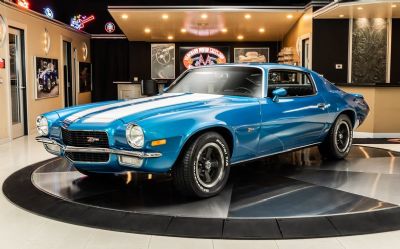Welcome to the ultimate source for Classic & Muscle Car Research.
 The second-generation Chevrolet Camaro, produced from 1970 to 1981, continued to build upon the legacy of the original Camaro while reflecting changes in automotive design, technology, and performance during a transformative era. This generation brought about significant changes to the Camaro's aesthetics, engineering, and market positioning, making it an emblem of the evolving automotive landscape.
The second-generation Chevrolet Camaro, produced from 1970 to 1981, continued to build upon the legacy of the original Camaro while reflecting changes in automotive design, technology, and performance during a transformative era. This generation brought about significant changes to the Camaro's aesthetics, engineering, and market positioning, making it an emblem of the evolving automotive landscape.
The design of the second-generation Camaro marked a departure from the first generation's sleek lines and emphasized a more muscular and aggressive appearance. With a longer, wider stance, the second-gen Camaro showcased a pronounced front end with single rectangular headlights flanking a wide grille. The body lines were more angular, and the rear quarter panels featured a distinctive crease, contributing to a sense of dynamism. The rear design saw a pronounced slope and a full-width taillight panel that gave the car a unique and recognizable rear view.
While the second-generation Camaro retained its muscle car spirit, it faced challenges from stricter emissions regulations and fuel economy concerns. As a result, the engine lineup underwent changes. A range of V8 engines was available, including small-block and big-block options, albeit with reduced power outputs due to emission controls. The Z/28 package continued to offer high-performance features, and a new LT (Luxury Touring) package aimed at providing a more refined driving experience. Notably, the introduction of the LT1 engine in 1970 maintained performance while meeting emissions standards.
The Z/28 package remained an important part of the second-generation Camaro lineup. It included high-performance components such as a performance-tuned suspension, special badging, and various performance upgrades. The Z/28 was designed for enthusiasts seeking track-oriented performance, and it continued to represent the spirit of Camaro's racing heritage.
The interior of the second-generation Camaro saw improvements in terms of comfort and convenience. The cabin offered more space and a user-friendly layout. Options for creature comforts increased, including air conditioning, power windows, and better sound insulation. These additions broadened the Camaro's appeal to a wider range of buyers.
The second-generation Camaro was produced during a time of significant changes in the automotive industry. The oil crisis, stricter emissions regulations, and evolving consumer preferences influenced design, performance, and engineering choices. The Camaro adapted to these changes by offering a range of powertrain options, from economical to performance-oriented, to cater to a diverse market.
Production of the second-generation Camaro concluded in 1981, marking the end of an era. It was succeeded by the third-generation Camaro, which embraced a more modern design and technology. Despite facing challenges, the second-generation Camaro left an indelible mark on automotive history, with its bold design, diverse engine options, and enduring place in the muscle car pantheon.
In summary, the second-generation Chevrolet Camaro represents a period of transition and adaptation in the face of changing industry dynamics. Its muscular design, performance heritage, and ability to adapt to evolving market demands ensure its place as a cherished classic that reflects the automotive landscape of the 1970s and early 1980s.
'71 Camaro Resto Mod 1971 Chevrolet Camaro SS Resto-Mod
'80 Camaro Z/28
'76 Camaro Half Top
'81 Camaro Coupe
'74 Camaro Z28
'71 Camaro Z/28 Tribute
'73 Camaro LS
'75 Camaro
Advertise Now!





